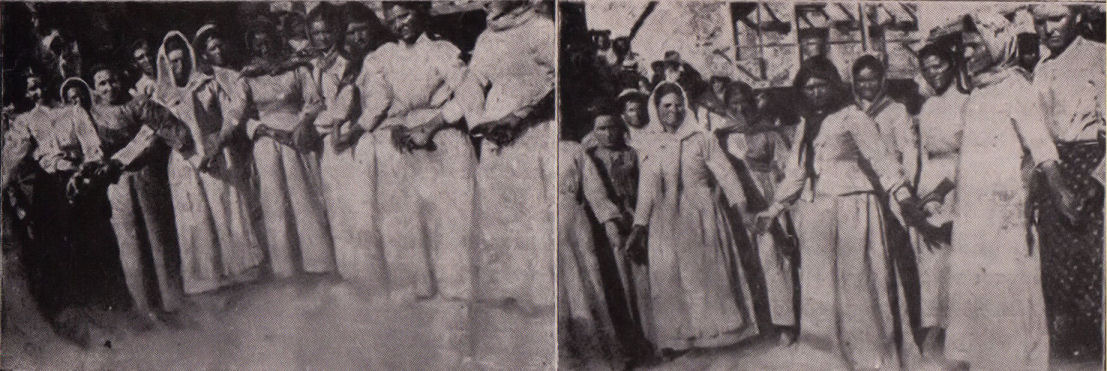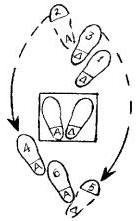Folklore
The Folk Songs of Arachova

The folk songs of Arachova have lyrics inspired by the Revolution of 1821, with clear references to both locations and names of the region, and the captains who were active in the area at the time. Its lyrics has lyrical elements of folklore of that period, as exemplifies "the little bird" that announces to the dead people their death, followed by the lament of relatives.
Ena poulaki eksevyene
Lyrics
Below are the lyrics of one of the folk songs of Arachova followed by a translation in english.
Ena poulaki eksevyene apo ton Agio Petro
{tr: A little bird comes from Agios Petros (near by village)}
Stous fonemenous kathete kai to Mystra agnanteuei
{tr: In fonemeni (location on ridge of mount Paron) sits and gazes over Mystras (Byzantine fortress-former Capital of Despotate of the Morea)}
Kai o Vaggelis to rota kai o Karanikolas
{tr: And Vaggelis and Karanikolas ask it}
Einai makria i Arachova apo ton Agio Petro?
{tr: Is Arachova far from Agios Petros?}
Dio ores einai, stratige, mia oste na ftaste.
{tr: It is two hours, General, one until you reach it.}
Eftou pou pate, stratige, omorfa na ferthite,
{tr: There that you go, General, you should nicely behave,}
Min pite t' ine ta Doliana t' Ai Petrou i agogiates
{tr: Don't assume that they are muleteers from Doliana (arcadic village) or Agios Petros}
Eki to len Arachova, to len Palia Barbitsa,
{tr: There has the name of Arachova, the name of old Barbitsa (Varvitsa is a near by village),}
Pohoun ton Petro stratigo, ton Kapetan Matala.
{tr: They have Petros as their general, the Captain Matalas (local hero during revolution war).}
Tris imeroules polemo kai tria meronuxtia.
{tr: Three days of war and three days and nights.}
Kai o Matalas milise sto stratigo Vaggeli:
{tr: And Matalas told to General Vaggelis:}
Vaggeli, rikse t' armata, Vaggeli gia proskuna,
{tr: Vaggeli through your armor, Vaggeli kneel down}
T' irthan apo ton Karytaina oi Kolokotronei
{tr: Kolokotronei (family members of great arcadian General Theodoros Kolokotronis) came from Karytaina (arcadic bastion of the revolution)}
Na se katevodosoune, to Argos na peraseis,
{tr: To send you off, to walk you through Argos (City of Argolis at north of the region)}
Na pas piso sti Vonitsa, stis kapetanopoules.
{tr: To go back to Vonitsa (town in west-middle Greece), to the kapetanopoules (wifes or mistresses of Generals)}
Klei tou Vaggeli i famelia kai tou Karanikola
{tr: The families of both Vaggelis and Karanikolas are crying}
Tou Kosta-Yina i adelfi tou leei miroloi.
{tr: Kosta-Yina's sister (Vaggelis' sister) sings a miroloi (dirge or funeral song)}
Na hamilonan ta vouna, na psilonan oi kambi
{tr: As if the mountains become lower, and higher the plains}
Na 'vlepan tin Arachova, tin penemeni xora,
{tr: Let them see Arachova, the praised land,}
Na 'vlepan t' aderfouli mou kai ton Karanikola,
{tr: Let them see my brother and Karanikola}
Opou tous makelokopse o Kapetan Matalas.
{tr: There where Captain Matalas butchered them.}
![]()
Sti Mesi stin Arachova
This particular Folk Song refers to the historical Arachova (Karyes of Laconia) and Vlachobarbitsa (Varvitsa of Laconia). Ibrahim after Messolonghi descended to the Peloponnese to stifle the revolution. During this campaign, he destroyed Arahova burning it on May 12, 1826. Only the holy temple of Agia Paraskevi stayed upright. The civilian population fled to the mountains, taking with them whatever things they could carry.
Three months later Ibrahim plundered the village and the surrounding area. During this pillage, several Arachovites and Vlachobarbitsiots were killed to fight hard to save their countryland. Nearly all of them fought in battle and died defending their Faith and Land, while some of those who were saved became slaves drawn to Pylos and were loaded on ships. Some paid ransom in order to come back, but on return they did not survive due to hardships. The people honored their heroism with the following song.
Lyrics
Sti mesi kale sto mesi sthn Arachova,
Sti mesi stin Arachova
kai sti Vlachobarbitsa
Pente kale pente polemoi ginontai,
pente polemoi ginontai
ap to proi os to gioma
Ki alli kale ki alli meta ap to deilino,
Ki alli meta ap to deilino
os pou na ksimerosei
Peftoun kale peftoun ta volia san vroxi,
Peftoun ta volia san vroxi
ki oi mpompes san xalazi
(OR: ki afta ta lianontoufeka san ammos tiw thalassis)
Metriounte kale metriounte oi Tourkoi tris fores
Metriounte oi Tourkoi tris fores
kai leipoun tris hiliades
Metriounte kale metriounte ta Ellinopoula
Metriounte ta Ellinopoula
kai leipoun tris leventes
![]()
The Arachovitikos (Karyatikos) Dance
The Arachovitikos dance is purely local and it used to be danced formally at the fests of Agia Paraskevi and Agios Panteleimon, which are believed to be arranged on the same days with "Karyateia". The rhythm of the dance is given by the song sung by the dancers (1). Caught in the grip of the hand palms, forming two concentric semicircles, the outer semicircle is the men and the women inside. But many argue that the dance is danced only by women (2), as in antiquity danced by the Caryatids. The female dancers form two semicircles, with the shorter from which in the inner one. Today the dance is still danced thanks to the efforts of the Cultural Association of Karyes and its dance group.

The Arachovitikos dance in 1945: 1st picture from left is first stasis and 2nd picture second stasis
The Dance and its Steps
Starting position the attention paid, and the music measure is 2/4 and 7/8 (2). The dance has two parts-"stasis", the first stasis and the second stasis. The first part has six steps, and the second part consists of two dozen-steps of Kalamatianos' dance. The dancers with synchronized, fast movements, lower their hands upon the heads of the dancers of the inside semicircle, then attached in front of the waist and thus transformed into a circle. The first and the last two semicircle of dancers link hands.
The steps of the first part are repeated 4 times in total. Simultaneously with the last step, the dancers circle out quickly and simultaneously raise their hands upon the heads of the dancers of the inside the semicircle, they lower also linked to the level of their waist and thus return to the original two concentric semicircles.
From this configuration they are dancing the steps of the second part, which consists of twelve steps of Kalamatianos' dance that are repeated two times. Along with the 24th step, the dancers are transformed back into a circle, as in the beginning, to repeat the dance. The outer circle of dancers, located in the voids of the interior, raise their hands and go over the heads of the dancers of the inner circle. So they form a circle and begin the 1st dance part.
 The steps of the first part of the dance are (3):
The steps of the first part of the dance are (3):
- The right foot in the center projection.
- The left foot in the center projection with strong support in the fingers.
- The right half a step towards the center, so that the arch of coming into contact with the heel of the left.
- The left back on projection,based on the tread.
- The right on projection back with strong support in the fingers directed slightly right.
- The left half a step backwards, the heel to come into contact with the arch of the right.

The Arachovitikos dance in a Mardi Gras event in Karyes (2009)
Lyrics
Below are the lyrics of the Arachovitikos Dance followed by a translation in english.
Stin apanou, Mario mou, geitonitsa
{tr: At the upper neighborhood, my Mario}
stin apanou geitonitsa | agapo m(n)ia kopelitsa
{tr: At the upper neighborhood I love a little girl}
Kai stin katou tin kaimeni | agapo m(n)ia pantremeni
{tr: And at the lower neighborhood | I love a married one}
Ma 'xe miti sa kontili | stoma san to dachtilidi
{tr: But she had a nose like a pencil | a mouth as a ring}
Ma 'xe ta mallia metaksi | kai plemena me tin taksi
{tr: But she had hair like silk | and bonded in class}
Ma 'xe fridia sa gaitani | pou zografos den ta fkiani
{tr: But she had eyebrows like gaitani (a farming tool shaped like a crescend moon) | that a painter cannot paint}
katou sto nero st' avlaki | ixa 'na perivolaki
{tr: Down in the water furrow | I have a small garden}
Ma 'xe mesa pasa pasa | olo laxana kai prasa
{tr: But it contained just | cabbages and leeks}
Ma 'xe m(n)ia milia sti mesi | pou vergologai na pesei
{tr: But it has an apple tree in the middle | that its branches bow to fall}
Kani mila san ta kitra | skoulikiarika kai tripia
{tr: It grows apples like citrus | with worms and holes}
Pai o nios na kopsei milo | ki apokrithike to fullo
{tr: The young man goes to cut an apple | and the leaf responed}
Mi mou koveis, nie, ta mila | giati ta 'xo i dolia liga
{tr: Young man, don't cut my apples | because, the poor, I have them few}
Ta 'xei afentis metrimena | ki i kira logodosmena
{tr: The master has them counted | and the lady promised for}
![]()












